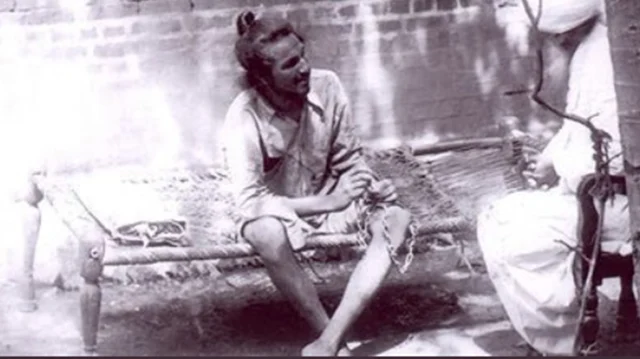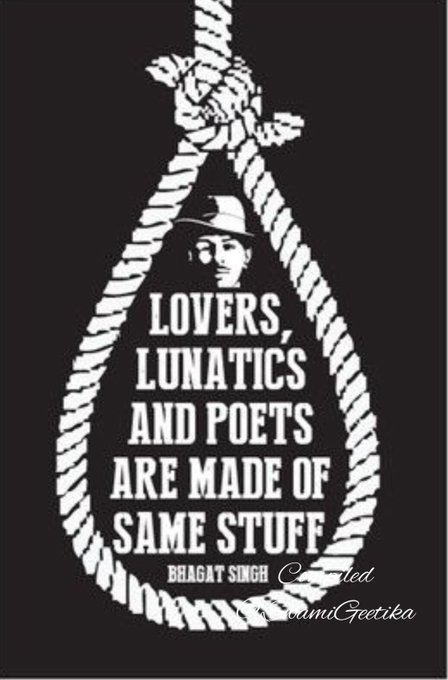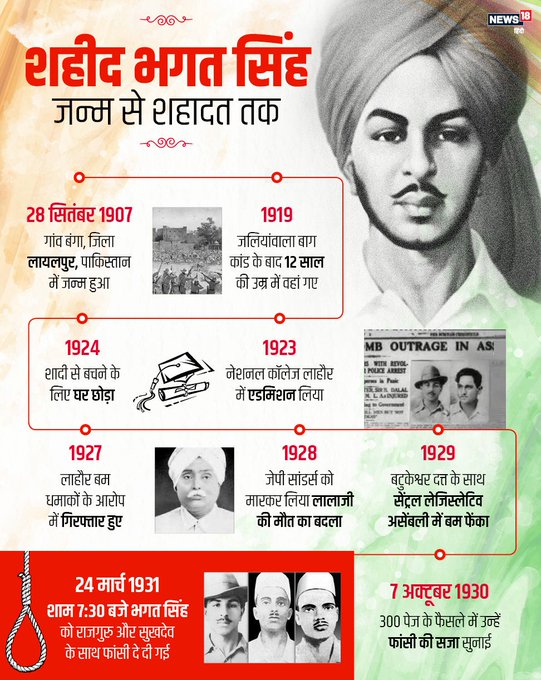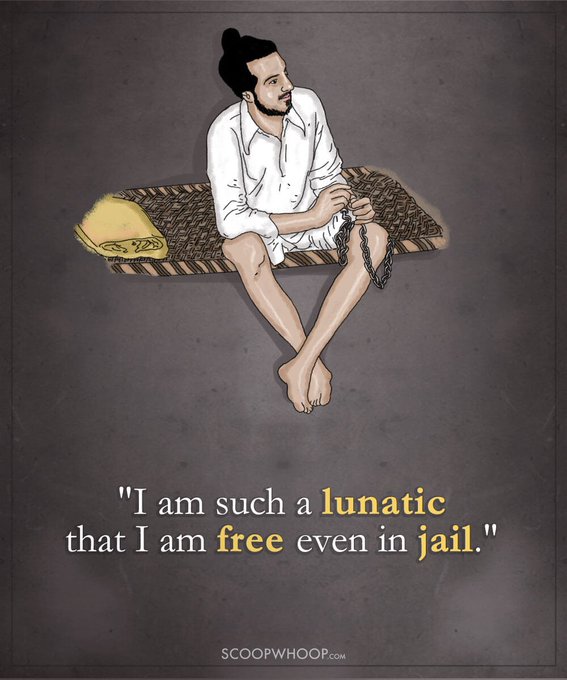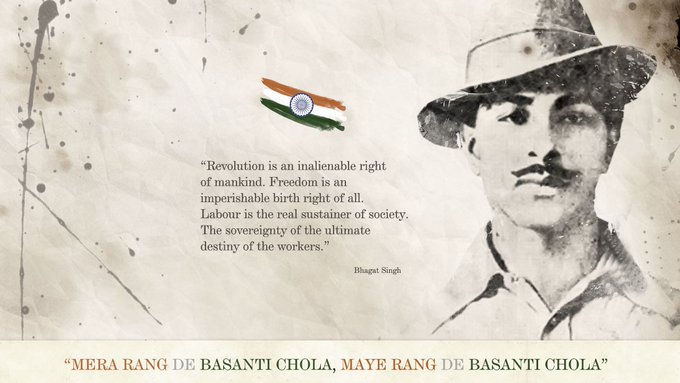8 अप्रैल 1929: एक दिन जिसे याद रखा जाना चाहिए : प्रो. चमनलाल

8 अप्रैल 1929 को भारत के राजनितिक इतिहास का एक ऐतिहासिक दिन था, जिसके बारे में एल.के. आडवाणी जी ने भारी तथ्य्तात्मक चूक करते हुए अपनी किताब ‘माय लाइफ माय कंट्री’ में भगत सिंह की फांसी के कारण को इस दिन से जोड़ा था, जिसके कारण उनकी इतिहास के प्रति समझदारी पर भी कई सवाल खड़े हुए. 8 अप्रैल के इस दिन के महत्व को हमें ऐतिहासिक दस्तावेजों के माध्यम से समझने और भगत सिंह और साथियों के योगदान से जुडी याद को आज भी फिर से याद करने की ज़रुरत है.
वह 8 अप्रैल दोपहर 12:30 बजे का समय था जब विट्ठलभाई पटेल (पहले उप-प्रधानमंत्री वल्लभ भाई पटेल के बड़े भाई) जो कि केन्द्रीय विधानसभा के अध्यक्ष थे, काफी गरमा-गर्मी और बहस के बाद जब वह ट्रेड डिस्प्यूट बिल और पब्लिक सेफ्टी बिल पर वह निर्णय सुनाने वाले थे (याद रहे यह वही बिल हैं जिनके दमनात्मक और जन-विरोधी चरित्र के कारण देश की जनता में पहले से ही काफी आक्रोश और असंतोष का माहौल था) सेलेक्ट कमिटी मीटिंग में अध्यक्ष होने की अपनी हैसियत से डाले गए कास्टिंग वोट के बावजूद भी पब्लिक सेफ्टी बिल पास नहीं हो पाया था. हालाँकि ट्रेड डिस्प्यूट बिल वो किसी तरह पास करा ले गए थे लेकिन इससे पहले की वह इसका नतीजा घोषित कर पाते वहाँ एक विस्फ़ोट हुआ, जिसके कारण विधानसभा के हॉल में चारो तरफ धुआं ही धुआं फैल गया और विजिटर्स गेलेरी से दो नौजवान तेज़ आवाज़ में नारे लगाने लगे, वे तीन नारे जो बार-बार दोहराए जा रहे थे, वे थे- ‘इन्कलाब जिंदाबाद’, ‘साम्राज्यवाद मुर्दाबाद’, ‘दुनिया के मजदूरों एक हो’. कुछ मिनटों बाद एक दूसरा विस्फ़ोट हुआ जिसके बाद असेंबली को जल्दीबाज़ी में ख़ाली कराया गया, फिर भी कुछ लोग वहाँ बचे रह गए जिनमें मोतीलाल नेहरु, मो. अली जिन्नाह, मदन मोहन मालवीय और तत्कालीन भारत सारकार के गृह सचिव जेम्स क्रेरार मौजूद थे. विजिटर्स गैलरी में जो लोग बैठे हुए थे उनमें देवदास गाँधी, महादेव देसाई, आसफ़ अली, वल्लभ भाई पटेल, ब्रजलाल नेहरु और सर शोभा सिंह, जॉन साइमन (जिन्हें साइमन कमीशन के कारण पहले से ही ख्याति/कुख्याति प्राप्त है) और ‘चाँद’ पत्रिका के ‘फांसी’ अंक के लेखक और संपादक चतुरसेन शास्त्री भी वहाँ अपने परिवार के साथ मौजूद थे जिन्हें भगत सिंह ख़ुद असेंबली में लेकर आये थे, और इसके साथ ही हिंदुस्तान टाइम्स के पत्रकार और क्रांतिकारियों के समर्थक चमनलाल भी वहां मौजूद थे जो वहां की कार्यवाहियों को कवर कर रहे थे.
वह 8 अप्रैल दोपहर 12:30 बजे का समय था जब विट्ठलभाई पटेल (पहले उप-प्रधानमंत्री वल्लभ भाई पटेल के बड़े भाई) जो कि केन्द्रीय विधानसभा के अध्यक्ष थे, काफी गरमा-गर्मी और बहस के बाद जब वह ट्रेड डिस्प्यूट बिल और पब्लिक सेफ्टी बिल पर वह निर्णय सुनाने वाले थे (याद रहे यह वही बिल हैं जिनके दमनात्मक और जन-विरोधी चरित्र के कारण देश की जनता में पहले से ही काफी आक्रोश और असंतोष का माहौल था) सेलेक्ट कमिटी मीटिंग में अध्यक्ष होने की अपनी हैसियत से डाले गए कास्टिंग वोट के बावजूद भी पब्लिक सेफ्टी बिल पास नहीं हो पाया था. हालाँकि ट्रेड डिस्प्यूट बिल वो किसी तरह पास करा ले गए थे लेकिन इससे पहले की वह इसका नतीजा घोषित कर पाते वहाँ एक विस्फ़ोट हुआ, जिसके कारण विधानसभा के हॉल में चारो तरफ धुआं ही धुआं फैल गया और विजिटर्स गेलेरी से दो नौजवान तेज़ आवाज़ में नारे लगाने लगे, वे तीन नारे जो बार-बार दोहराए जा रहे थे, वे थे- ‘इन्कलाब जिंदाबाद’, ‘साम्राज्यवाद मुर्दाबाद’, ‘दुनिया के मजदूरों एक हो’. कुछ मिनटों बाद एक दूसरा विस्फ़ोट हुआ जिसके बाद असेंबली को जल्दीबाज़ी में ख़ाली कराया गया, फिर भी कुछ लोग वहाँ बचे रह गए जिनमें मोतीलाल नेहरु, मो. अली जिन्नाह, मदन मोहन मालवीय और तत्कालीन भारत सारकार के गृह सचिव जेम्स क्रेरार मौजूद थे. विजिटर्स गैलरी में जो लोग बैठे हुए थे उनमें देवदास गाँधी, महादेव देसाई, आसफ़ अली, वल्लभ भाई पटेल, ब्रजलाल नेहरु और सर शोभा सिंह, जॉन साइमन (जिन्हें साइमन कमीशन के कारण पहले से ही ख्याति/कुख्याति प्राप्त है) और ‘चाँद’ पत्रिका के ‘फांसी’ अंक के लेखक और संपादक चतुरसेन शास्त्री भी वहाँ अपने परिवार के साथ मौजूद थे जिन्हें भगत सिंह ख़ुद असेंबली में लेकर आये थे, और इसके साथ ही हिंदुस्तान टाइम्स के पत्रकार और क्रांतिकारियों के समर्थक चमनलाल भी वहां मौजूद थे जो वहां की कार्यवाहियों को कवर कर रहे थे.

इस घटना के काफ़ी वर्षों बाद आसफ अली ने एक साक्षात्कार के दौरान इस बात का खुलासा किया की असेम्बली में जो दो बम फेंकें गए उन्हें भगत सिंह द्वारा ही फेंका जाना था पर क्योंकि बी.के. दत्त भगत सिंह से दूर नहीं रहना चाहते थे और हर अच्छे बुरे समय में उनके साथ बने रहना चाहते थे इसलिए उन्होंने उन दो बमों में से एक बम की ज़िम्मेदारी ले ली थी.
नारेबाजी और गुलाबी रंग पर्चों को हॉल में उड़ाने के कुछ देर बाद सारजेंट टेरी और इंस्पेक्टर जॉनसन इन दो युवाओं की ओर बढ़े जिनमें से एक नौजवान (भगत सिंह) अपनी बन्दूक से खेल रहा था. पुलिस ऑफिसर डर के कारण इन नौजवानों की और बढ़ नहीं पा रहे थे, उनके इस डर को देखकर इन नौजवानों ने वहाँ पड़ी साइड-टेबल पर अपनी पिस्तौल रख दी. इसके बाद इन दोनों को गिरफ्तार कर लिया गया. दोनों ही ख़ाकी शर्ट और शॉर्ट्स में थे और उनमें से एक ने फेल्ट हैट पहना हुआ था. हैट पहने हुए नौजवान का नाम भगत सिंह था और उनके दूसरे साथी का नाम बटुकेश्वर दत्त था. जयदेव कपूर नाम के उनका तीसरे साथी इस धमाके के तुरंत बाद ही हॉल से निकल गए और किसी असेम्बली सदस्य से प्राप्त उन पासों को जला दिया जिसके ज़रिये वे सभी असेम्बली में घुसे थे. भगत सिंह, बी. के. दत्त और जयदेव कपूर ये तीनों ही लोग विधानसभा के परिसर में इस घटना से पहले भी आते रहे थे इसका प्रमाण 6/4/1929 के CID रिकॉर्ड में पाया गया था और इतना ही नहीं HSRA के कमांडर चंद्रशेखर आज़ाद भी उस परिसर के प्रमाणिक अनुभव को हासिल करने के लिए वहां आते रहे थे जिससे कि कार्यवाही को कुशलता से अंजाम दिया जा सके. जो पर्चे विधानसभा में उड़ाए गए थे उन्हें बलराज नाम के व्यक्ति के नाम से जारी किया गया था जो चन्द्रशेखर आज़ाद का ही पार्टी नाम था. इस पर्चे को भगत सिंह ने लिखा था. यह परचा एक फ्रेंच क्रन्तिकारी वेलियाँ के कोटेशन से शुरू होता था ‘कि बहरों को सुनाने के लिए धामाके की ज़रुरत होती है’ चार दशक पहले इस फ्रेंच क्रांतिकारी वेलियाँ ने भी कुछ इसी प्रकार की कार्यवाही को फ़्रांस की संसद में अंजाम दिया था और उन्हें भी इस कार्यवाही के लिए मौत की सजा दी गयी थी. 8 और 9 सितम्बर 1928 को दिल्ली के फ़िरोजशाह कोटला मैदान में हिन्दुस्तान सोशलिस्ट रिपब्लिकन एसोसिएशन की स्थापना हुई और लाला लाजपत राय की हत्या के दोषी सांडर्स की हत्या के बाद वहीं इस कार्यवाही की योजना भी तैयार की गयी थी. 30 अक्टूबर 1928 साइमन कमीशन के ख़िलाफ़ एक विरोध मार्च का नेतृत्व करते हुए लाला लाजपत राय को सांडर्स ने लाठियों से पीटा जिसके कारण उन्हें गंभीर चोटें आयीं और 17 नवम्बर को उनका देहांत हो गया.
कोर्ट और पुलिस के अनुसार 8 अप्रैल को असेम्बली में किये गए इस धमाके में केवल 6 लोगों को बहुत मामूली सी चोटें आयीं थीं. मेडिकल रिपोर्ट भी चोटों की साधारणता की पुष्टि करती है. असेम्बली में रखे कुछ फर्नीचर क्षतिग्रस्त हुए थे जिसमे सीट नम्बर 87-88-89 और 146-147-148 शामिल थीं. इस अवसर पर भगत सिंह द्वारा पहनी गयी फेल्ट हैट उन्होंने दिसम्बर 1928 को कलकत्ते से ख़रीदी थी और पिस्तौल उन्हें ढाका के एक पुराने क्रांतिकारी प्रतुल दास द्वारा दी गयी थी. 8 अप्रैल को असेम्बली के अंदर जाने से पहले भगत सिंह ने अपनी घड़ी जयदेव कपूर को दी थी जो उन्हें शचीन्द्र नाथ सान्याल से मिली थी, और शचीन्द्र नाथ सान्याल को यह घड़ी रासबिहारी बोस से मिली थी फिलवक्त ये घड़ी हरदोई में है. असेम्बली में जाने से पहले भगत सिंह ने अपने नए जूते भी जयदेव के पुराने जूतों से बदल दिए थे.
इस घटना को अंजाम देने के क्रम में भगत सिंह और बटुकेश्वर दत्त दिल्ली के सीतराम बाज़ार(फ़रवरी-मार्च) और नई सड़क(अप्रैल के प्रथम सप्ताह) पर किसी के घर रुके थे. 7 अप्रैल की रात में सुखदेव, भगवती चरण वोहरा, दुर्गा भाभी, और सुशीला दीदी को लाहौर से दिल्ली लाये थे जिससे कि वे भगत सिंह से आख़िरी बार मिल सकें. 8 अप्रैल की सुबह वे दिल्ली के कुदसिया बाग़ में पहुंचें, जहाँ उन्होंने भगत सिंह को उनकी पसंदीदा चीजें रसगुल्ले और संतरे खिलाये. सुशीला दीदी ने भगत सिंह के माथे पर खून से तिलक लगाया और इसके बाद 10:30 बजे भगत सिंह असेम्बली जाने के लिए रवाना हुए. भगत सिंह और बटुकेश्वर दत्त को जब गिरफ्तार कर ले जाया जा रहा था तब भगवती चरण वोहरा, दुर्गा भाभी और उनके तीन वर्ष के बेटे शचि ने उन्हें जाते हुए देखा. शचि ने भगत सिंह को देखते ही ‘लम्बू चाचा’ कहकर आवाज़ लगायी, दुर्गा भाभी ने शचि के मुहँ पर अपना हाथ रख दिया. अप्रैल 3 या 4 को भगत सिंह और बटुकेश्वर दत्त ने कश्मीरी गेट पर रामनाथ नाम के फोटोग्राफर से एक तस्वीर भी खिंचवाई थी. फेल्ट हैट पहने हुए भगत सिंह की वो तस्वीर ऐतिहासिक बन गयी और भारतीय जन मानस पर ही नहीं बल्कि उनके मन मस्तिष्क पर भी जो विदेशों में हैं हमेशा-हमेशा के लिए अंकित हो गयी. जयदेव कपूर और शिव वर्मा को कुछ दूसरे कामों की ज़िम्मेदारी दी गयी. भगत सिंह ने जिन पर्चों को असेम्बली में फेंकने के लिए टाइप किया था उनकी 10-15 कॉपी बनायीं थी. इस घटना के तुरंत बाद फोटोग्राफ के साथ बयान की कॉपियां पत्रकारों को वितरित कर दी गयीं. दुर्गा दास जो उन दिनों ‘द स्टेट्समैन’ की प्रतिनिधि थे उन्होंने सरकारी प्रकोप से बचने के लिए बयान की प्रति को कलकत्ता के बजाए लन्दन तक टेलीग्राफ करने की ज़िम्मेदारी ली और यह तरकीब काम कर गयी. चमन लाल ने असेम्बली से उन पर्चों की प्रतियाँ लीं और हिंदुस्तान टाइम्स ने घटना की शाम को ही इस घटना पर अपना एक विशेष सांध्य अंक निकाला. इस घटना को अंतर्राष्ट्रीय स्तर पर जाना गया. हिंदुस्तान टाइम्स स्वतंत्रता संग्राम के समर्थक होने के कारण उन दिनों ब्रिटिश हुकूमत की आँखों की किरकिरी बन चुका था. 8 अप्रैल से 12 जून के बीच जब सेशन जज द्वारा भगत सिंह और दत्त को उम्र कैद की सजा सुनाई गयी उस दौरान CID की कई रिपोर्ट्स में उन दिनों हिंदुस्तान टाइम्स के राष्ट्रवादी रुझान और भूमिका का उल्लेख किया गया है. HT के सहायक संपादक घोष को क्रांतिकरियों के कामों के प्रति सहानुभूति रखने वाला बताया गया है. यहाँ तक कि ऐसा भी माना गया कि कई पुलिस वालों ने हिन्दुस्तान टाइम्स को इस केस से सम्बंधित अंदर की ख़बरें पहुंचाने का काम किया है. हिंदुस्तान टाइम्स के स्टाफ सदस्यों पर दिल्ली में भगत सिंह और दत्त को संरक्षण देने का शक़ भी था. 13 मई को सहारनपुर के एक घर में छापेमारी के दौरान भगत सिंह और दत्त कुछ फोटोग्राफ और नेगेटिव प्राप्त हुए जिसे बाद में फोटोग्राफर रामनाथ ने पुलिस द्वारा पहचान परेड कराये जाने के दौरान पहचाना भी. CID रिपोर्ट्स के रिकॉर्ड से यह पता चलता है कि लाहौर से प्रकाशित होने वाले ‘बंदेमातरम’ के 12 अप्रैल के अंक में इन फोटोग्राफ्स को प्रकाशित किया गया पर CID रिकार्ड्स से ही यह भी पता चलता है कि लाहौर में आम लोगों के बीच इन तस्वीरों का वितरण 11 अप्रैल से ही शुरू हो चुका था, जिससे की इनकी लोकप्रियता का अंदाजा लगाया जा सकता है.

ड्यूटी कांस्टेबल लाला हंसराज साहेब द्वारा भगत सिंह और दत्त के ख़िलाफ़ एक्सप्लोसिव एक्ट 1908 के सेक्शन 34 के तहत FIR दर्ज कराई गयी. भगत सिंह के पिता किशन सिंह को 3 मई 1929 को उनसे मिलने की इजाज़त मिल पाई जब यह पता चला कि भगत सिंह के दस वर्षीय छोटे भाई जो उस समय पांचवी कक्षा का छात्र था वह भी गिरफ़्तार किया गया है. भगत सिंह अपने केस में किसी भी तरह की सफाई पेश करने या कोई कानूनी मदद प्राप्त करने हक़ में नहीं थे इसलिए आसफ़ अली की मदद से भगत सिंह और बटुकेश्वर दत्त ने अपना केस ख़ुद ही लड़ा. केस की सुनवाई 7 मई 1929 से शुरू हुई. भगत सिंह का कोर्ट में दिया गया ऐतिहासिक बयान ख़ुद भगत सिंह ने तैयार किया जिसे आसफ़ अली ने और परिष्कृत किया था. हालाँकि 9 जून को जज द्वारा उस बयान के कुछ हिस्सों को रिकार्ड्स से हटवा दिया गया. 12 जून 1929 को कोर्ट ने अपना फैसला सुनाया जिसके अनुसार दोनों क्रांतिकारियों को उम्रकैद की सज़ा सुनाई गयी. इस निर्णय के ख़िलाफ़ हाई कोर्ट में अपील दायर की गयी. लेकिन जस्टिस ई. फोर्ड और जस्टिस एडिसन ने इस अपील जिसे अपील नंबर 748 के नाम से भी जाना जाता है उसे 13 जनवरी, 1930 को ख़ारिज कर दिया और सज़ा को जारी रखा. हालाँकि जजों ने अपने फैसले में भगत सिंह को एक ईमानदार क्रांतिकारी माना है.
भगत सिंह और दत्त को पहले मियांवाली जेल और फ़िर लाहौर जेल ले जाया गया. जहाँ जेल में मूलभूत सुविधाओं के अभाव के ख़िलाफ़ उन्होंने 15 जून, 1929 को भूख हड़ताल शुरू की. बाद में जब 10 जुलाई 1929 को लाहौर षड्यंत्र केस की कार्यवाही शुरू हुई तब उन्हें भी बाकी आरोपियों के साथ लाहौर जेल भेज दिया गया. वह 25 दिन से भूख हड़ताल पर थे जिसके कारण उन्हें वहां स्ट्रेचर पर लाया गया. लाहौर केस के अन्य आरोपियों ने भी 13 जुलाई से भूख हड़ताल शुरू कर दी जिसके कारण 13 सितम्बर को भूख के कारण क्रांतिकारी जतिन दास की जेल में ही मृत्यु हो गयी. 7 अक्टूबर 1930 को भगत सिंह को लाहौर षड्यंत्र केस में फांसी कि सज़ा सुना दी गयी. इसके ख़िलाफ़ प्रिवी काउंसिल से की गयी अपील भी फ़रवरी 1931 को ख़ारिज कर दी गयी. जिसके परिणामस्वरूप 23 मार्च, 1931 को भगत सिंह, राजगुरु और सुखदेव को फांसी दे दी गयी.
जेल से बाहर आने के बाद बटुकेश्वर दत्त पटना में रहे और 1965 में दिल्ली के AIIMS में उनका देहांत हो गया. दत्त के देहांत के समय भगत सिंह की माँ विद्यावती उनके पास थीं. दत्त की इच्छानुसार उनका अंतिम संस्कार हुसैनीवाला(फिरोज़पुर, जहाँ पर भगत, सुखदेव और राजगुरु का अंतिम संस्कार हुआ था) में किया गया. उनका समाधि स्थल भी बाकी तीन शहीदों के साथ ही वहाँ स्थित है. ब्रिटिश राज के ख़िलाफ़ लड़ाई से लेकर जीवन के अंतिम क्षण तक बटुकेश्वर दत्त का अपने कामरेडों के साथ खड़े रहने का जज़्बा आज की नौजवान पीढ़ी के लिए भी प्रेरणादायी है.
(इस लेख में संसद की बम धमाके से क्षतिग्रस्त जिन सीटों का उल्लेख है या विजिटर्स गेलरी की उन सीटों पर जहाँ पर भगत सिंह और दत्त बैठे थे, उन सीटों पर आज़ादी के 71 साल बाद भी स्मृति पट्टिकाएं तक नहीं लगाई गयीं हैं जबकि इसकी मांग बहुत बार हो चुकी है. सोमनाथ चटर्जी जैसे प्रगतिशील लोकसभा अध्यक्ष के कार्यकाल में भी यह काम नहीं किया जा सका. आज भी कई सांसदों के द्वारा इस मांग को उठाया जा रहा है)
प्रो. चमन लाल के अंग्रेजी लेख का अनुवाद: उमा ’राग’ और मीनाक्षी बरगोहाईं द्वारा
(दोनों ही अनुवादक दिल्ली विश्वविद्यालय के इंद्रप्रस्थ कॉलेज में प्राध्यापक हैं)
(दोनों ही अनुवादक दिल्ली विश्वविद्यालय के इंद्रप्रस्थ कॉलेज में प्राध्यापक हैं)

